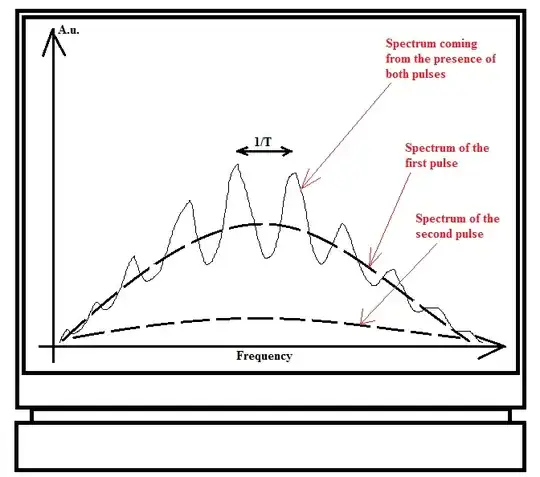OK, that's nice, but let's make it a bit more explicit by talking about light. Let me borrow this schematic as a representative optical spectrometer:

This spectrometer works by taking our signal as a single point source and collimating it with a mirror, then passing it through a grating, and then using a second mirror to focus the resulting rainbow onto the detector. In this simplified picture, it is very similar to most optical spectrometers out there, and what follows applies very broadly to that class.
Unfortunately, there is something that tends to get lost when people are discussing this picture, at least at the level of introductory optics textbooks, and it's the fact that this sort of configuration tends to muck about with the temporal details of the pulses. This is normally dropped because it doesn't matter when all you want is an understanding of the optics of the spectrum. However, when we want to look at interference between temporally-separated pulses, then it obviously matters.
To see what I'm talking about, consider the path taken by the red-light component on the two rays that pass at the extremes of the grating:

The thing to notice here is that the two path lengths are different, with the path on the left being longer. The dot marks the spot on that path where it has the same length as the path on the right.
This is the crucial insight, because it means that even if I start with a pulse that is localized in time, it will be stretched in time when it gets to the detector, because different parts of the signal for the red detector pixel traverse different path lengths.
To see this a bit more clearly, let me draw some surfaces of equal time for the different rays involved:

Here I'm plotting circles at equal distance from the source that correspond to rays that go through the two extremes of the diffraction grating, one pair just before the mirror and one pair just before the detector. As you can see, the rays that pass through the right of the diffraction grating come significantly in advance of the rays that pass through the left of the grating.
This, in turn, has a strong effect on the shape of the pulse. To see this, let me fill in the region between these surfaces with light of the corresponding colour:

(Just to clarify, this is simply a linear fill-in of the different wavelengths, which in essence ignores the curvature of the collimating mirror.) If you then push this forward a bit more, you can get the full temporal evolution of the pulse through the spectrometer:

Mathematica notebook used to produce this animation available through Import["http://goo.gl/NaH6rM"]["https://i.stack.imgur.com/DxUGm.png"]
It's important to remark that this is in fact what the pulse will look like spatially, in the regime where you start with a very short pulse. In that case, say, if your pulse lasts 10 fs and therefore has an original spatial width of 3mm, the real-world spatial size of your pulse in the above diagram will be in the range of several centimeters, so your pulse has been stretched significantly. (If your pulse is much longer than that originally, of course, then this will represent a smearing instead.)
We see, then, that the pulse has been stretched spatially by a fair amount. The next question is, of course, by how much has it been stretched? It should be clear from the diagrams that the amount of stretching increases with the width of the grating, and that for wider gratings the pulse will be temporally stretched more and more.
This becomes even more relevant when you consider the main reason that we would want a wider grating on our spectrometer which is to get a better wavelength resolution. In other words, if you want to measure with a finer frequency resolution, you need to use measurements that take longer and longer and... well, hello there, uncertainty principle!
You can now see where this is going: if you want a spectrometer with enough resolution to resolve the ${\sim}1/T$ interference between your two pulses, then the spectrometer will necessarily stretch the pulses by an amount greater than the inter-pulse separation $T$. This then means that within the spectrometer the two pulses do coincide in both space and time, and it's perfectly reasonable for them to interfere, locally, at each pixel of the CCD detector.
Pretty neat, huh?







